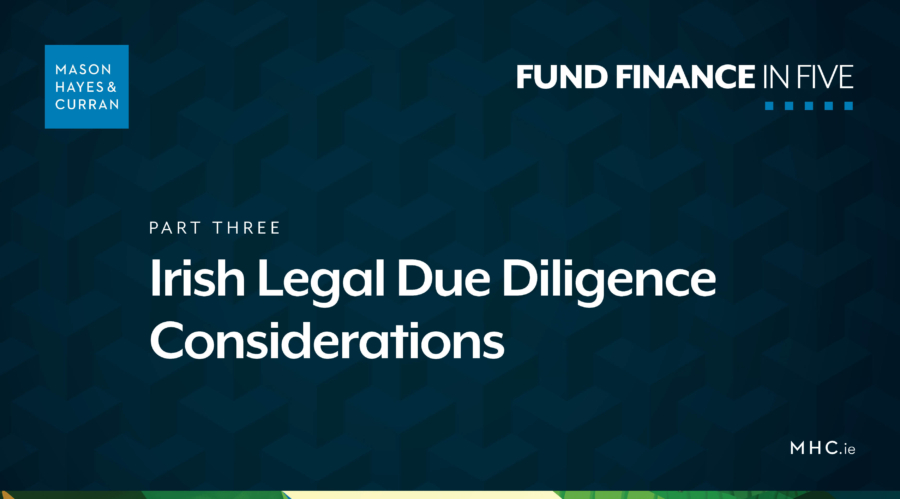Irish Fund Finance in Five – Part 3
Irish Legal Due Diligence Considerations

Download full Fund Finance in Five series
Ireland is currently home to over 8,880 funds with over €4.9 trillion in net assets. More than 1,000 fund managers from over 50 different countries have assets administered in Ireland, including 17 of the top 20 global asset managers. As a destination for fund managers, Ireland offers access to the EU-wide marketing passport for UCITS and AIFs. Accordingly, Ireland is established as a domicile of choice for the global investment funds industry and the fund industry in Ireland continues to grow year on year.
In addition to the growth of the Irish investment funds industry, the global fund finance industry has experienced rapid growth over the last number of years. The fund finance industry has proven itself to be robust and withstood a number of external market factors and periods of volatility, such as:
- The current higher interest environment
- The exit of certain market participants, and
- Onerous capital requirements for financial institutions
As both the Irish investment funds industry and the global fund finance industry continues to grow, naturally the number of fund finance transactions involving Irish vehicles also continues to grow. Over time, Ireland has proven itself to be a convenient jurisdiction in which to conduct fund finance transactions. With its English-speaking population and its common law legal system, market participants based from other jurisdictions (such as the UK and the US) often find transactions involving an Irish nexus to be convenient and familiar.
We have prepared this “Irish Fund Finance in Five” series to act as a comprehensive overview of all things Irish law related in the fund finance market. This series will be split into five parts, consisting of:
- Part 1 – Common Irish Legal Issues in Fund Financings
- Part 2 – Irish Security Considerations
- Part 3 – Irish Legal Due Diligence Considerations
- Part 4 - Irish Subscription Documents Considerations
- Part 5 – Overview of Irish Fund Structures
The issues examined by us in this series act only as a summary and are not intended to be exhaustive. As readers will appreciate, this series should not be considered a substitute for legal advice and lenders and funds should engage legal counsel at the outset of a transaction to ensure that these issues are given appropriate consideration.
Download full Fund Finance in Five series
Introduction
In Part 3 of our “Irish Fund Finance in Five” series, we set out and discuss the Irish specific issues to look out for when carrying out due diligence in fund finance transactions involving an Irish nexus. The importance of identifying applicable issues early in the process cannot be understated. In doing so, the borrower and lender can be allowed time to discuss and structure the transaction appropriately. In addition, to the extent required, early identification can enable proactive engagement with other key stakeholders such as investors and fund service providers. In particular, when carrying our Irish legal due diligence we often consider the following questions:
- Who is the appropriate party to bind the fund borrower?
- Does the fund borrower have capacity to enter into the proposed transaction?
- What other parties are required for the fund borrower to enter into the transaction and/or to comply with its obligations over the term of the transaction?
- In an enforcement scenario, how would a secured party realise their security?
- Is there pre-existing debt within the fund structure?
- Why has the borrower sought to include “limitation” wording in the finance documentation?
1. Who is the appropriate party to bind the fund borrower?
As will be examined in more detail in Part 5 (Overview of Irish Fund Structures) of our “Irish Fund Finance in Five” series, there are a variety of different structures that Irish investment funds may be established under. When looking to document any transaction with an investment fund, one of the first and most fundamental issues is to ensure that the appropriate party binds the fund borrower. In order to determine this, the fund borrower’s offering and constitutive documents need to be reviewed in detail.
In most circumstances, the answer to this question should be easily determined. For example, where the fund is a separate legal entity, e.g. an investment company or an ICAV, the fund borrower can contract on its own behalf through its directors/authorised signatories. In other circumstances, the analysis may be more complicated, particularly in instances where the underlying fund does not have separate legal personality. For example, an Irish unit trust is established through the trust deed and the contractual terms of this trust deed must be reviewed in detail to establish which entity has authority to enter into a proposed transaction, usually either or both of the manager or trustee of the unit trust. Lenders and their counsel will also require formal board authorisations and certificates from the relevant party to demonstrate that it has taken the necessary steps to authorise its entry into the finance documents.
Irish regulated fund structures are commonly organised in the form of umbrella schemes with segregated liability between different portfolios/compartments, often referred to as "Sub-Funds". Even though a fund structure itself may have separate legal personality, where it is established as an umbrella scheme, each Sub-Fund does not have its own separate legal personality. Accordingly, the appropriate party that can bind the fund, e.g. the fund itself, the manager or the trustee, will need to enter into the finance documentation on behalf of the Sub-Fund to bind it.
Finally, it is common for an Irish investment fund to delegate, through its fund documents, authority to certain other parties, including the manager or an investment manager, to enter into transactions on behalf of the investment fund. The rationale for this is to streamline the operation of the investment fund in its ordinary course of business, and to facilitate its pursual of its investment objectives. This type of delegated authority may extend to the entry into and consummation of lending transactions on behalf of the fund. However, in lending transactions, it will generally be a requirement that the finance documents are also executed by the fund itself rather than solely being executed by any delegate or sub-delegate. Where the fund does not have separate legal personality, it will be a requirement that the finance documents are executed by the primary fund party to whom the fund’s constitutional documents delegate this authority. This is required due to the greater legal scrutiny typically required in lending transactions and to give legal counsel sufficient grounds for providing their legal opinions.
2. Does the fund borrower have capacity to enter into the proposed transaction?
Another fundamental issue is whether the fund borrower has the capacity and is permitted to enter into the proposed transaction. To determine this, the fund borrower’s constitutive documents, offering documents, subscription documents (if applicable) and applicable legislation need to be reviewed in detail. Following the completion of this review, it may be that restrictions are identified which impact on the proposed transaction, such as restrictions on:
- The amount and/or duration of any borrowing or the act of borrowing itself
- The creation of security, generally or over the specific assets purported to be secured pursuant to the proposed transaction
- Guaranteeing, noting the regulatory restriction on third party guarantees examined in Part 1 - Common Irish Legal Issues in Fund Financings of this “Irish Fund Finance in Five” series
- The purpose for which borrowing can be availed of, whether linked to the investment objectives or otherwise, and
- Interest rate or hedging transactions.
For Net Asset Value (NAV)-based financing facilities, readers may be aware that the Institutional Limited Partners Association (ILPA) recently released new guidance regarding the recommended practices to be adopted when dealing with NAV facilities. Amongst these recommendations was that, unless expressly permitted by the governing documents of the relevant fund, the consent of the investors should be obtained when looking to implement NAV facilities. Lenders and their counsel should be cognisant of this guidance when considering a proposed NAV financing.
On occasion, there can be ambiguity in the wording and/or conflicting provisions which may set out restrictions or limits in connection with the entry into financing transactions. In this case, a number of factors will need to be considered in order to determine the appropriate course of action, such as:
- On balance, how would the intended restriction or limit likely be construed
- If adversely construed, what would the consequences of a breach of the restriction or limit be, and
- What steps would be required to amend the relevant constitutive or offering documents to remedy the issue.
In order to amend the constitutive or offering documents, it may be the case that the consents are required from third parties, such as investors, which may not be desirable or possible in the circumstances.
A fund borrower may have the capacity to enter into a fund finance transaction, and all required corporate authorities may have been obtained. However, the proposed terms of the transaction must also be consistent with the fund borrower’s offering and constitutive documents. For example, in a subscription line facility, the term of the facility should not extend past the expiry of the period in which capital calls can be made from investors.
A fund may appoint third party service providers to carry out certain functions on its behalf. As examined in further detail in Part 2 - Irish Security Considerations of this series, quasi-security rights may be given to these service providers which can cut across the security package being granted to a lender. Accordingly, the documents appointing these service providers should be examined at an early stage by lender’s counsel.
Finally, while not a common feature in fund finance transaction, a 60% leverage limit, to be calculated as total debt to total assets, applies to Irish funds which invest at least 50% of their assets directly or indirectly into Irish real estate.
3. What other parties are required for the fund borrower to enter into the transaction and/or to comply with its obligations over the term of the transaction?
When reviewing the constitutive documents and fund documents, any ancillary actions that are required from fund parties in connection with the proposed transaction should be identified. In certain circumstances, these documents may provide that an investment committee or advisory board need to consent to or approve certain categories of transaction, such as borrowing and/or granting security. This authorisation or consent would be required to be obtained in addition to the usual board approvals.
By way of example, we recently advised on two concurrent but entirely separate financings to two different Irish unit trust borrower funds. In the first transaction, the trust deed provided that the trustee was required to exercise any borrowing on behalf of the unit trust borrower, provided it had received the proper instructions of the manager. In the second transaction, the trust deed provided that the manager was permitted to grant security on behalf of the unit trust borrower, provided that it had received the consent of the trustee. Accordingly, it was key that the correct approvals, those being the relevant consent/proper instructions letters, were included as conditions precedent to those financings.
It will also need to be determined how the fund borrower will ensure compliance with its covenants under the finance documents. This determination may be made by a combination of reviewing the underlying fund documents and understanding how the fund operates in its ordinary course of business. This process may also require a discussion with the fund operations team and relevant fund service providers. By way of example, lenders may require account viewing rights or certain information, such as the NAV, regarding the fund’s underlying investments. Any requirements for account mandates, access to online platforms and/or fund service provider side letters should be included as conditions precedent to the transaction documents and obtained prior to closing.
4. How would a secured party realise their security in an enforcement scenario?
As with any secured financing, a key focus of the due diligence will be establishing the lenders’ means of realising its security in a non-performance scenario and using the proceeds received to discharge the secured obligations. These due diligence considerations will depend on the nature of the security.
For any fund finance transaction where security is being granted over a fund’s accounts, it is fundamental that account control agreements are provided. These agreements will set out the level of control that a lender may exercise over the secured accounts and will directly influence the lender’s ability to enforce its security over these accounts. We have discussed the use of account control agreements in further detail in Part 2 - Irish Security Considerations of this series.
For subscription line facilities, the key area of legal due diligence will be the subscription documents, which we will examine in more detail in Part 4 - Irish Subscription Documents Considerations of our series. The main issue for the lenders will be to ensure that the investors’ obligation to fund capital commitments is robust and that the secured party will have direct recourse to those commitments in an enforcement scenario. It may be the case that certain other parties, such as the manager, investment manager, or administrator, enter into a side letter with the lender or grant security interests in its favour. This approach ensures that the lender has direct and enforceable recourse to the capital commitments of the fund’s investors. The circumstances in which a fund is permitted to make distributions or dividend payments to investors should also be examined and lenders should consider whether any restrictions should be placed on the fund’s ability to make such payments. For lenders, the fund will ideally be restricted from making these payments to investors while an event of default is continuing.
For NAV or hybrid facilities, the legal due diligence will ultimately depend on the assets which are intended to form part of the security package. They would also need to be considered on a deal-by-deal basis. Where security is being granted over shares/units in a fund/sub-fund, the governing documents of the fund should be examined to determine whether those shares/units can be mandatorily redeemed in certain circumstances. In an enforcement scenario, a lender will want the power to exercise control over the relevant fund/sub-fund and powers which provide for the mandatory redemption of such shares may cut across this power. By way of example, from some recent transactions we worked on:
Example Transaction 1
We advised on the Irish law aspects of a facility made available to an Irish feeder fund, which was to be used to subscribe for units in the Irish master fund. In that transaction, the security package was entirely Irish law governed and comprised of security over:
- A cash account owned by the feeder fund, which the redemption proceeds of its master fund units were to be paid into
- The securities account, in which the master fund units were recorded, and
- The master fund units owned by the feeder fund.
A key element of the legal due diligence was to ensure that the lender had the ability, in an enforcement scenario, to direct for the master fund units to be redeemed and for the proceeds of such redemption to be used to discharge the secured liabilities. In this specific transaction, it was apparent that the administrator, in its capacities as administrator of the feeder fund and the master fund had a key role in (i) delivering the redemption request on behalf of the feeder fund and (ii) paying the proceeds of any redemption to the feeder fund’s bank account. Accordingly, a side letter was put in place with the administrator to ensure that it would act as required by the lender in an enforcement scenario.
Example Transaction 2
We acted as Irish counsel regarding a facility made available to an Irish fund, which was to be used to fund investments/subscriptions in certain eligible funds. In that transaction, the borrower had certain accounts located in the U.S. and the eligible funds were domiciled in Luxembourg and Cayman Islands. A fundamental part of the due diligence exercise was to ensure that the lender had recourse to these accounts and shares in the relevant funds. Accordingly, specific New York, Luxembourg and Cayman Islands legal advice was taken and the security package consisted of:
- New York law governed account pledges
- A Luxembourg law governed security agreement for shares held in Luxembourg eligible funds, and
- A Cayman Islands law governed security assignment for limited partnership interests held in certain Cayman Islands eligible funds.
It should also be ascertained whether there are circumstances which allow the fund to be wound up by its board of directors. The board of directors are often given broad powers under the offering and constitutive documents of the fund, which can occasionally grant an ability to wind the fund up before its maturity date. Where such rights exist, lenders will typically look to curtail them by incorporating the required covenants into the finance documents or by requiring the fund’s governing documents themselves to be amended.
5. Is there pre-existing debt within the fund structure?
It is common for certain assets within the fund structure to be the subject of pre-existing security in favour of third parties. Where a prospective lender is looking to lend into a similar structure, one of the key commercial points that will need to be agreed between the parties is what indebtedness or security is permitted to be incurred by the fund borrower. Where any existing indebtedness and/or security is not permitted, it will need to be discharged and released prior to closing.
A search of the Irish Companies Registration Office may identify pre-existing security created by Irish incorporated companies. A search should be conducted in this registry in a number of cases, such as where the fund borrower is an Irish investment company or the general partner, trustee and/or manager, as applicable, is an Irish incorporated company. Similarly, a search of the Irish Central Bank’s Register of Charges may identify pre-existing security created by Irish ICAVs. Legal counsel acting for any incoming lender should conduct these searches at the outset of a transaction. However, it is worth noting that not all security is registerable in the Irish Companies Registration Office or the Irish Central Bank, such as charges over accounts or securities.
It may be the case that a fund has borrowed from its own investors. In these circumstances, an incoming lender should look to have the fund’s repayment obligations towards its investors subordinated to its obligation to repay the incoming lender. This is generally done via a subordination agreement. The existence of any loans with investors ought to be determined at an early stage, as the investors may be required to sign the subordination agreement. This can require prolonged engagement and negotiations, which can cause delays to the transaction.
6. Why has the borrower sought to include “limitation” wording in the finance documentation?
Where the borrower fund is a Sub-Fund, it is customary for segregated liability wording to be included in any finance documentation to which it is party. The segregated liability concept is provided for by statute in the case of a number of Irish funds structures, such as ICAVs, ILPs and investment companies. That said, we would still expect to see explicit wording covering this off in the finance documentation. Lenders’ legal counsel should review the proposed segregated liability wording to ensure it does not go further than it is intended to.
Where facilities are provided to S.110 borrowers, the S.110 company is typically structured to be bankruptcy remote and it is customary to include limited recourse and non-petition wording within the finance documents. Lenders will need to be made aware of the implications of this wording at the outset of the transaction.
Conclusion
The legal due diligence process can frequently bring key issues into focus at the outset of a transaction. In rare circumstances, the legal due diligence may identify issues meaning that the proposed transaction is no longer feasible. More commonly, the legal due diligence will identify issues that need to be addressed in order for the transaction to proceed. Accordingly, it is critical that these issues are considered from the outset of a transaction, ensuring efficiency from a cost perspective and reducing any potential timing delays. Failure to conduct a thorough legal due diligence process could result in serious issues for the lenders further down the line, particularly where the loan facility becomes non-performing.
For more information and expert advice, please reach out to a member of our Fund Finance team. Stay tuned for the remaining issues of our ‘Fund Finance in Five’ series.
The content of this article is provided for information purposes only and does not constitute legal or other advice.
Share this:




